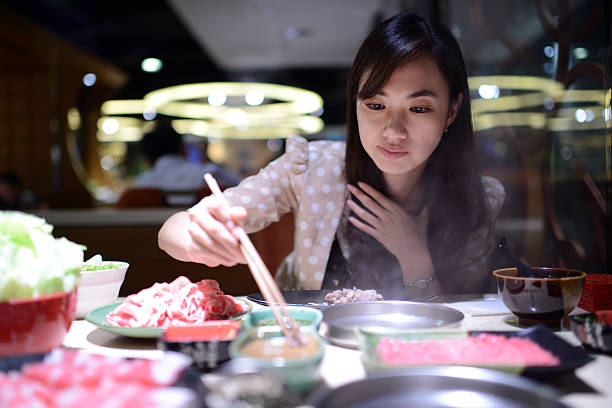Hot pot is a shared eating experience that originated in Eastern Asia. It involves patrons ordering different ingredients to boil in a large pot of broth and placing it on their table.
According to historians, the idea of hotpot was born when leaders of Mongolian tribes traveled across their territory to sample the cuisines of different regions.
Although hot pot is deeply rooted in Asian culture, it hasn’t yet taken off beyond Asia. This is likely why many of you don’t know what hot pot is.
You don’t have to be embarrassed to try hot pot. Zimu Chen (hot pot expert, owner of Baba in Massachusetts) was our guest to discuss how to make hot pot correctly. We were able to present to you a Beginner’s Guide To Hot Pot. Chen shared some of his hot pot secrets with us and recommended the best choices for first-timers.
Tom Yum
This Thai sauce has lemongrass, chili peppers, and fish sauce. It also contains lime juice, lime juice, lime leaves, and lime leaf. The chili adds some heat, but only a little. This is balanced by the lemongrass and lime flavors.
Chen stated that Tom Yum is his favorite – great for flavoring meats. Tom Yum is a great choice for making a heavy-meat hot pot. It has good heat but doesn’t burn your throat. It leaves you with a refreshing citrus taste that is refreshing.
Ma-la (Szechuan)
Do you love spicy food? This curry-like broth is a perfect choice. These earthy flavors, including chilies, ginger chilies, cinnamon, anise, anise, and ginger, are great for meats and vegetables.
Chen says that this is one of the most popular hot pot broths. However, there are better choices for those who don’t love curry. It might not be the best choice for your first hot pot experience unless you prefer strong spices.
MEATS
Chen says you don’t have to worry about eating raw meat in a hot pot.
“Hot pot meats can be cut very thin, so they take only a few seconds to cook. Although you must dip them multiple times to achieve fully cooked meat, it takes only a minute.
While most meats can be used in a hot pot, Chen recommends using chicken, pork, chicken, and lamb. For a novice to hot pot, any of these options are great. Chen also enjoys more unusual meat options (such as organ meats or “offal”) in hot pots.
Chen stated that the best thing about hot pot meat options is the possibility to try something unusual, such as beef tripe. You can experiment with something you wouldn’t usually try, and it’s not the only thing you’re trying. Your broth, sauces, and vegetables are all there — you can disguise your beef tripe.
VEGETABLES
The wide variety makes it hard to choose vegetables for hot pot. The Baba selection includes watercress, lettuce and tomatoes, baby bokchoy, tofu, and potatoes.
Chen stated that vegetables could be divided into two types: absorbing flavor and imparting flavor.
Vegetables like tomato and corn will flavor watery broths (like chicken broth). Baby bok choy is great for taking in the flavor of solid broths (like ma-la).
Chen also said that the best part of the hot pot is the vegetable section, which he calls mushrooms.
Chen stated that mushrooms are my favorite food. He tries at least two types of mushrooms in every hot pot he makes. “Usually, I pair stronger-tasting mushrooms like enoki with lighter varieties like king trumpet mushrooms. Combinations like these are great for beginners.
SEAFOOD
As with meats, seafood is better when paired with certain broths than others. You can find seafood options at most hot pot restaurants, including lobster, crab and haddock, oysters, shrimp, seabass, and squid.
“I love to combine shrimp with Tom Yum broth. Tom Yum broth is Thai, and traditional Thai food would include shrimp to emphasize the flavors of Tom Yum,” Chen stated. Shrimp takes only 1-2 minutes to cook. It is annoying to peel the shrimp during cooking, but shrimp is excellent for a first-time option if everyone contributes.
NOODLES
Noodles in the hot pot are responsible for absorbing as much flavor as possible from the broth. Depending on the type of noodles you choose, you can rely on them to add texture to the pot.
You should know a few things about Shangdong, vermicelli, and vermicelli.
Chen suggests that beginners to hot pot try Shangdong noodles. They’re a mix of vermicelli and udon. Their thickness retains the flavor but has texture, so you don’t feel like eating anything.
SAUCE
Hot pot has a long tradition of the hot pool where customers can make their sauce. This is done by combining different condiments and being served to everyone at the beginning of the meal.
Hot pot sauces include scallions, chopped garlic, chili, and soy sauce. You can make a dipping sauce from these ingredients, so experiment with other condiments.
Chen stated that sauces are a matter of personal preference. You can use any combination of flavors that you like. You can also ask your server to add a new flavor to your sauce if it isn’t already.



